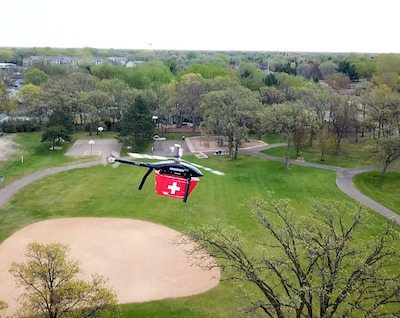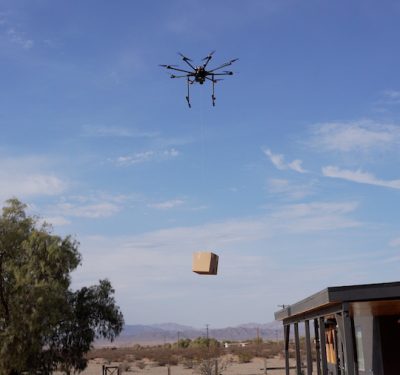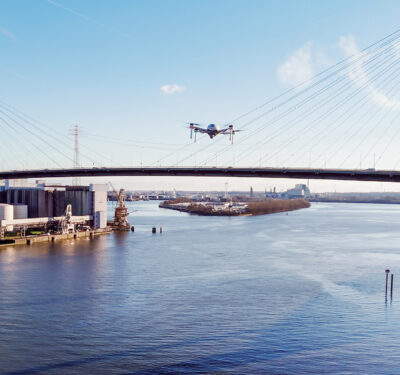
On July 29, more than a year after RaceDayQuads’ co-founder and CEO Tyler Brennan filed RaceDayQuads (RDQ) v. FAA to challenge the legality of the Federal Aviation Administration’s (FAA) remote identification (RID) rule, the U.S. Court of Appeals for the D.C. Circuit handed the agency the win. It’s important to understand the context for the ruling, what the court did or did not say and what it could mean for the future of drone flight.
The Rule from the 30,000-foot View
The Congressionally-mandated RID rule to protect airspace safety and national security requires all U.S. small drones to broadcast a publicly accessible “digital license plate.” These message elements (MEs) include the drone’s unique identifiers and relevant locational data. Manufacturers can either bake this capability into the drone (Standard Remote ID) or design a module to attach to it (Broadcast Module RID, or BMID). Non-RID-compliant drones can only fly in FAA-recognized identification areas (FRIAs). Law enforcement agencies can triangulate MEs with FAA drone registration data.
“The drone system’s real-time location data says nothing qualitative about the nature of the location nor the operator’s relationship to it (e.g. whether he is at his home).”
U.S. Court of Appeals for the D.C. Circuit
The rule, published in January 2021, took more than two years to finalize. The public provided 53,000-plus wide-ranging comments; the FAA published almost 500 pages of accompanying explanatory text.
A surprise to many, the final rule deviated from the FAA’s Notice of Public Rulemaking (NPRM) in big ways. Arguably, the most significant change was the shift from a network-based RID focus to a broadcast solution. This formed part of the basis of RDQ’s challenge. RDQ said the final rule was “not a logical outgrowth” from the NPRM.
Brief of the Briefs
In brief, RDQ outlined four additional arguments: the rule violated the Fourth Amendment by permitting persistent warrantless tracking; the FAA “arbitrarily and capriciously” relied on non-public ex parte communications during the rulemaking process; the FAA did not consult with the Radio Technical Commission for Aeronautics (RTCA) and the National Institute of Standards and Technology (NIST) as legally required; and there was a failure to address significant public comments, as required by the Administrative Procedure Act (APA).
In the fall, the FAA fired back, as did the Association for Uncrewed Vehicle Systems International (AUVSI), which filed a “friend of the court” brief in support of the agency’s position. The parties argued before a three-judge panel in December. In an interesting twist, much discussion revolved around the FAA’s authority to govern airspace down to the lowest blade of grass, otherwise known as avigation rights.
By far, however, the Fourth Amendment issue took up the most air time. The judges appeared inclined to find that people have both property and privacy rights “below the tree line” and over their privately owned property, in certain circumstances, which seemed to be the nail in the coffin for RID.
Then, more than seven months after those arguments, and about 45 days before the rule’s mandatory compliance deadline for original equipment manufacturers (OEMs), the court ruled against RDQ.
Nothing to See Here
RDQ argued that the RID rule was facially invalid under the Fourth Amendment because RID’s persistent GPS tracking capabilities, accessible by law enforcement without a warrant, would interfere with one’s reasonable expectation of privacy. The court disagreed.
“…Drone pilots generally lack any reasonable expectation of privacy in the location of their drone systems during flight…”
U.S. Court of Appeals for the D.C. Circuit
Because drones fly in public and in the air, the court said “…drone pilots generally lack any reasonable expectation of privacy in the location of their drone systems during flight…” The rule, it noted, does not otherwise authorize privacy-invading practices because it:
- Calls for installation, not monitoring by law enforcement: The requirement to install a tracking device does not, in and of itself, constitute illegal tracking.
- Gives only short-term access to location information: RID broadcasts start and stop with takeoff and landing. The court expanded on this: “the drone system’s real-time location data says nothing qualitative about the nature of the location nor the operator’s relationship to it (e.g. whether he is at his home).” The rule also does not authorize the aggregation and storage of flight data for later law enforcement queries.
- Still requires law enforcement to abide by the Constitution: The rule itself actually says this, and the court locked onto that: “Nothing about the Rule itself supports Brennan’s assertions that it will be used by [sic] government in ways that violate drone pilots’ privacy rights.”
Here’s the clincher, per the court: “We…do not foreclose the possibility of a declaratory judgment or injunctive action by a party establishing that application of the Remote ID Rule to its own specifically delineated drone uses would subject it to an unconstitutional privacy deprivation.” (Emphasis added).
In other words, while the court found the rule good to go on its face, it left the door open to future case-specific challenges.
Playing By the Rules
RDQ raised a number of procedural matters that the court also struck down.
- No ex parte communication affected the rule: The court believed RDQ failed to show a material effect or harm from off-the-record FAA meetings with an industry-based cohort and others.
- The final rule was a logical outgrowth of the proposed rule: Claims about FAA changes in measuring the altitude of drone control stations and the switch from a network to a BMID drone failed because the NPRM and FAA requested comment on them.
- There was no consultation failure: The court said the FAA consulted with RTCA and NIST as part of its 2017 Unmanned Aircraft Systems Identification and Tracking Aviation Rulemaking Committee. It side-stepped the fact that the resultant report failed to discuss FRIAs while noting, apples to oranges, that the public had commented on the FRIA proposal.
- The FAA adequately responded to significant comments: With a wave of the wand, the court said RDQ’s allegations that the FAA failed to address significant public comments (around the rule’s legal basis, constitutional limits, calculation of regulatory costs and treatment of drone hobbyists’ interests) were either frivolous, premature or that the FAA otherwise addressed them sufficiently.
Implications, Gaps and Signals
The stakes in this case were high. Had RDQ won, the RID rule would have been vacated. This would have forced an FAA redo. It would have set the commercial drone industry back years, given that the FAA added RID requirements to Category 2 and 3 operations over people and future low-altitude UAS traffic management systems. But a deeper legal dive may have provided the much-needed clarity for the industry.
“We…do not foreclose the possibility of a declaratory judgment or injunctive action by a party establishing that application of the Remote ID Rule to its own specifically delineated drone uses would subject it to an unconstitutional privacy deprivation.”
U.S. Court of Appeals for the D.C. Circuit
For purposes of the Fourth Amendment, this case stands for the proposition that drone pilots generally lack a reasonable expectation of privacy in the location of their drone systems during flight. The court specifically mentioned open fields, outside a residence where they can be viewed from a public route or adjoining premises or in the curtilage of a home, even behind a hedge or fence, if possible to be viewed by “naked-eye observation” from an “aircraft lawfully operating” above the property. Hence, law enforcement would not require a warrant in those instances.
Where a warrant would otherwise be required—which still remains uncertain in drone cases—the court seems to assume that, despite RID-enabled access to protected privacy information, law enforcement will abide by the constitution and the law.
On the other hand, the ruling failed to answer key constitutional questions:
- When would law enforcement need a warrant to correlate MEs and FAA data? Under what circumstances could a drone pilot establish that application of the RID Rule would amount to an unconstitutional privacy deprivation?
- Does the “special needs” exception to the warrant requirement apply? The court chose not to address this because they found no “search” here.
- What about avigation rights? Despite spending significant time dwelling on this issue during arguments, the judges failed to address it.
From a procedural standpoint, this case illustrates that federal agencies have wide latitude in the administrative rulemaking process. Even so, perhaps a bit more transparency and clarity could lead to less skepticism about agency actions.
And Now for the Next Broadcast
Is this over? Under Rule 40 to the Circuit Rules of the U.S. Court of Appeals for the D.C. Circuit, RDQ could petition the court for a rehearing within 45 days of the judgment.
Such a petition would have to state with particularity each point of law or fact RDQ believes the court has overlooked or misapprehended, and argue in support of its position. If the court granted a rehearing, which is rare, it could make a final call without reargument, reschedule the case to the calendar or just issue any other appropriate order.
In addition to the lingering legal ambiguities of the RDQ case, the technological requirements to implement RID remain elusive. How will it work? The means of compliance (MOC) for minimum performance standards for UA and BMID modules still don’t exist. How will the required message elements be “beamed” to the public? The court mentions that folks can read RID on an app. Where? By what technical means and process will law enforcement and security agencies triangulate MEs and FAA database information?
At least folks have a bit over 30 days to sort all of this out and about a year for drone pilots to comply.






